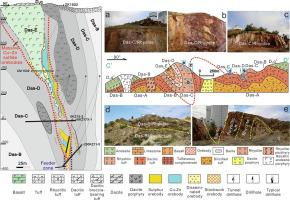当前位置:
X-MOL 学术
›
Ore Geol. Rev.
›
论文详情
Our official English website, www.x-mol.net, welcomes your
feedback! (Note: you will need to create a separate account there.)
A revised stratigraphic and tectonic framework for the Ashele volcanogenic massive sulfide deposit in the southern Chinese Altay: evidence from stratigraphic relationships and zircon geochronology
Ore Geology Reviews ( IF 3.2 ) Pub Date : 2020-12-01 , DOI: 10.1016/j.oregeorev.2020.103814 Lei Niu , Tao Hong , Xing-Wang Xu , Hang Li , Qiang Ke , Xue-Hai Wang , Yin-Che Ma
Ore Geology Reviews ( IF 3.2 ) Pub Date : 2020-12-01 , DOI: 10.1016/j.oregeorev.2020.103814 Lei Niu , Tao Hong , Xing-Wang Xu , Hang Li , Qiang Ke , Xue-Hai Wang , Yin-Che Ma

|
Abstract The Ashele volcanogenic massive sulfide (VMS) deposit is the largest and most representative VMS deposit in the Chinese Altay Metallogenic Belt, but its stratigraphic sequence, tectonic framework, and morphology are debated. In this paper, on the basis of previous research, field investigations, excavation pits, drill-core sampling, and new LA–ICP–MS U–Pb analyses of zircons from mafic and felsic volcanic rocks, we show that the main structure of the Ashele deposit is an overturned tightly closed syncline, and that the primary orebody is controlled by this structure. Moreover, we show that the Ashele VMS deposit displays a double-layer structure made up of a feeder zone of veinlet-disseminated and stockwork orebodies overlain by massive/stratiform orebodies that are folded. We revise the stratigraphy of the Ashele Formation into five conformable sedimentary subsequences, based on new field investigations and the zircon geochronology of each subsequence. From bottom to top, we divide the formation into a siliceous tuff layer (405.1 ± 1.8 Ma), a dacitic layer (395.9–403 Ma), a rhyolitic layer (390.9 ± 0.83 Ma), an orebody layer (ca. 387 Ma), and a basalt layer (387–377 Ma). The Early to Middle Devonian Ashele Formation unconformably underlies the Late Devonian Qiye Formation.
更新日期:2020-12-01











































 京公网安备 11010802027423号
京公网安备 11010802027423号